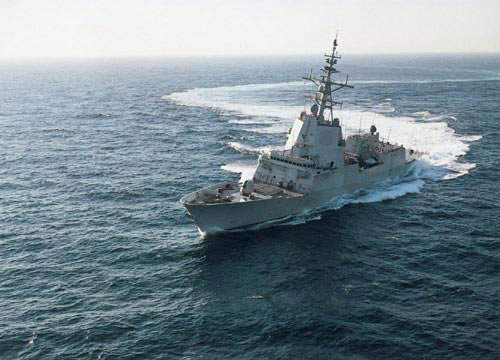The F100 Alvaro de Bazan Class is a 5,800t multipurpose frigate built by the Spanish shipbuilder, Izar (formerly E.N. Bazan). In February 2005, the naval shipbuilding activities of Izar were spun off into a new company, Navantia.
The first batch of four ships was ordered by the Spanish Navy in January 1997. The first, Alvaro de Bazan (F101), was launched in October 2000 and commissioned in September 2002. The second, Almirante Juan de Borbon (F102), was launched in February 2002 and commissioned in December 2003.
The third, Blas de Lezo (F103) was launched in May 2003 and commissioned in December 2004. The fourth, Mendez Nunez (F104), was launched in November 2004 and delivered in March 2006.
In June 2005, the Spanish Government announced plans to procure a fifth Alvaro de Bazan Class vessel, Cristobal Colon (F105). Procurement of the new vessel was authorised by the government in May 2006. Construction began in June 2007 and the keel was laid in February 2009. The ship was launched in November 2010 and entered sea trials in June 2012. A sixth vessel, Juan de Austria (F106) is also planned, to commission in 2013.
Alvaro de Bazan Class Aegis combat system
The ship incorporates the AN/SPY-1D Aegis Combat System from Lockheed Martin Naval Electronics and Surveillance Systems. The main missions of the ship are fleet protection, anti-air warfare, operation as a flag ship for a combat group, anti-surface and anti-submarine warfare.
In June 2008, Spain requested the foreign military sale (FMS) of Raytheon Tomahawk Block IV land attack missiles to arm the F100 frigates.
Alvaro de Bazan is the first European ship with the Aegis weapon system. In July 2003, Alvaro de Bazan (F101) took part in combined Combat Systems Ship Qualification Trials (CSSQT) with the Aegis Class destroyer USS Mason (DDG 87). A second CSSQT trial took place in September 2004 with Almirante Juan de Borbon (F102) and USS Pinkney (DDG 91). In June 2007, Mendez Nunez (F104) took part in the first tri-nation CSSQT, with Arleigh Burke class destroyer USS Gridley (DDG 101) and the Royal Norwegian Navy frigate Fridtjof Nansen (F310).
In 1994 Spain entered an agreement with Germany and the Netherlands, which provided cooperation in development and in national construction of the frigates. In Spain, Izar built the F100, in the Netherlands, Royal Schelde built the LCF (De Zeven Provincien Class) and in Germany the ARGE 124 group (Blohm and Voss as the leading yard, Howaldtwerke-Deutsche Werft and Thyssen Nordseewerke) built the F124 (Sachsen Class). The agreement covered cooperation on the ship platform and not on the systems.
Aegis combat data system
The Aegis combat data system controls the detection, control and engagement sequence through the AN/SPY-1D radar, the command and decision systems (C&D) and the ship’s weapons control system (WCS). The F100 is the first frigate to be equipped with Aegis.
The ship has satellite communications and Link 11 secure tactical data link.
Weapons systems
The ship has two four-celled Boeing Harpoon anti-ship missile systems. Harpoon is a medium-range missile with a range of 120km, 220kg warhead and active radar terminal guidance. The surface-to-air missile system is the evolved Sea Sparrow missile (ESSM) developed by an international team led by Raytheon.
ESSM has semi-active radar guidance with tail control motor to improve range, speed and manoeuvrability. The medium-range Raytheon standard missile SM-2MR Block IIIA provides area defence. SM-2MR has a range of 70km, a speed of Mach 2.5 and has semi-active radar seeker and an Aegis radio command link. Both ESSM and SM-2MR use the Lockheed Martin Mark 41 vertical launch system.
The ship is equipped with the BAE Systems, Land & Armaments (formerly United Defense) mk45 mod 2 gun controlled by the DORNA radar / electro-optic fire control system from FABA. DORNA sensors include K-band radar and tracking radar along with an infrared camera, TV and laser rangefinder.
The close-in weapon system (CIWS) is the 20mm Meroka 2B also from FABA. The Meroka CIWS includes infrared camera, video autotracker and is cued by the Aegis radar. Meroka has a range of 2,000m. There are also two 20mm machine guns.
The ship has two mk32 double torpedo launchers for mk46 lightweight torpedoes and also two anti-ship mortars.
Sikorsky Seahawk helicopters
The F100 has a flight deck 26.4m long and will accommodate one helicopter. The Spanish Navy has acquired six new Sikorsky SH-60B LAMPS Mk III Seahawk helicopters.
A programme to upgrade six existing Seahawk helicopters to LAMPS mkIII standard was completed in January 2004. The helicopters are equipped with a FLIR and Hellfire laser-guided air-to-surface missiles and are deployed on the F100 and Santa Maria Class frigates.
Countermeasures suite
The ship’s countermeasures suite includes Aldebaran Electronic Support Measures / Electronic Countermeasures (ESM/ECM) system, from Spain’s Indra Group, four Lockheed Martin Sippican mk36 SRBOC chaff and decoy launchers and the AN/SLQ-25A Nixie acoustic torpedo countermeasures system from Argon ST of Newington, Virginia.
Sensors
The first four F-100 ships are equipped with the Lockheed Martin AN/SPY-1D fixed phased array radar for air and surface search. AN/SPY-1D is a multi-function E/F band, three-dimensional radar which is an essential part of the Aegis system. It provides instantaneous beam steering, target detection, fire control tracks on hundreds of targets, and multiple target kill assessment.
The fifth vessel, Cristobal Colon (F105), is fitted with the SPY-1D(V), which includes an upgrade to improve littoral performance. The air-search radar is the three-dimensional TRS and surface-search radar is the G/H band AN/SPS-67(V)3 from DRS technologies.
The hull-mounted sonar is the Raytheon DE1160 LF active and passive sonar. The Sikorsky SH-60 Seahawk helicopter is equipped with AN/SQQ-28 LAMPS III sonobuoys.
CODAG propulsion system
The F100 is equipped with a combined diesel and gas propulsion (CODAG) system with two GE LM 2500 gas turbines providing 34.8MW and two Navantia diesel engines rated 9MW. The shafts drive two controllable pitch propellers.












